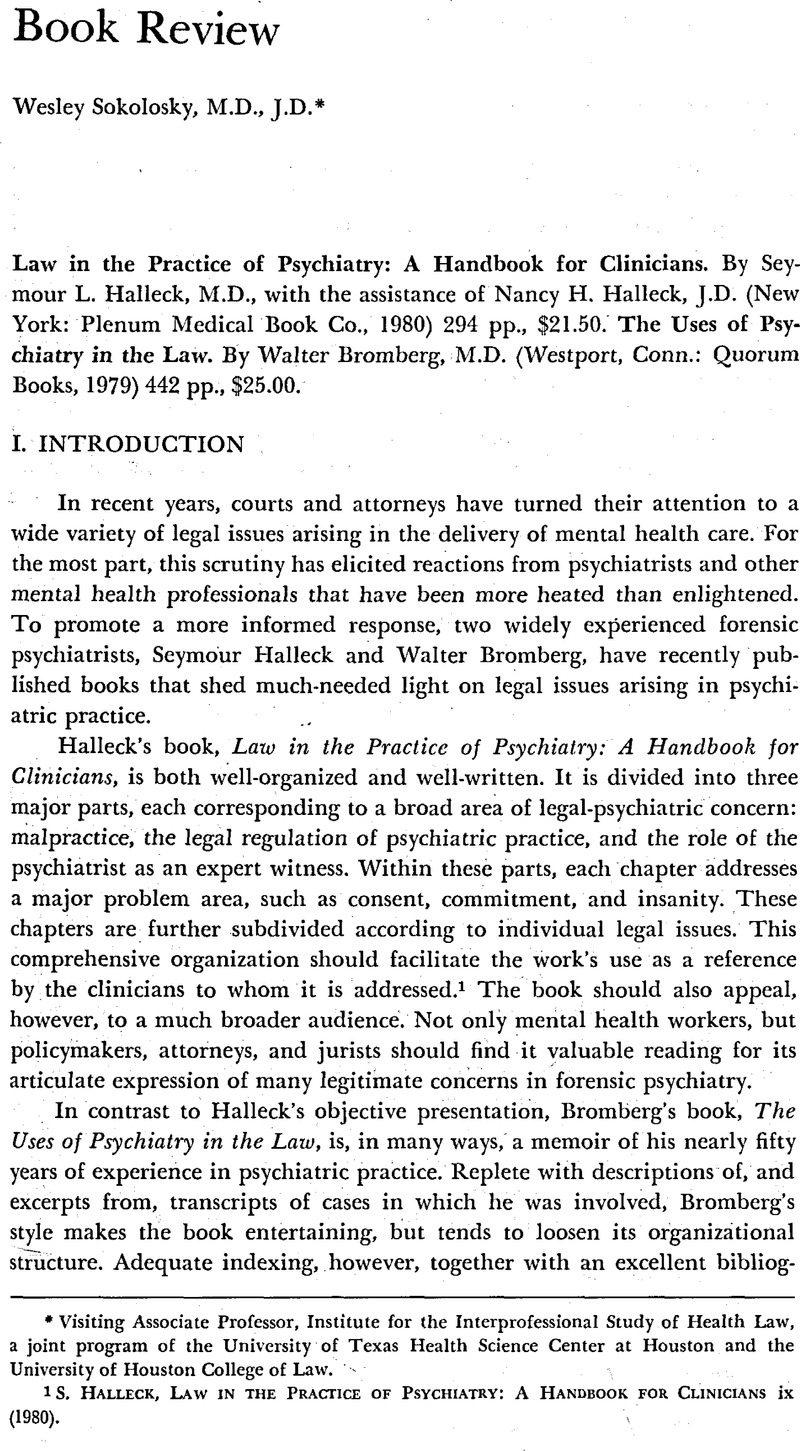No CrossRef data available.
Published online by Cambridge University Press: 06 May 2021

1 Halleck, S., Law in the Practice of Psychiatry: A Handbook for Clinicians ix (1980)CrossRefGoogle Scholar.
2 Bromberg, W., The Uses of Psychiatry in the Law ix (1979)Google Scholar.
3 Bromberg, supra note 2, at 5-9.
4 Id. at 39-65.
5 471 F.2d 969 (D.C. Cir. 1972).
6 Bromberg, supra note 2, at 55-61.
7 Halleck, supra note 1, at 207-29.
8 Id. at 208-12.
9 Id. at 225-26.
10 Bromberg, supra note 2, at 66.
11 33 Cal. 2d 330, 202 P.2d 53 (1949). Wells held that evidence of an abnormal mental state short of legal insanity was admissible as relevant to the issue of criminal intent.
12 51 Cal. 2d 715, 336 P.2d 492 (1959). Gorshen held that evidence of an abnormal mental state could be sufficient to negate the required criminal intent, without requiring a finding that the defendant was insane.
13 Bromberg, supra note 2, at 78-87.
14 Id. at 39.
15 Halleck, supra note 1, at 207.
16 Id. at 235-37; Bromberg, supra note 2, at 101.
17 Id. at 100-01.
18 Id. at 90-100. of the three syndromes named, only one, the Ganser Syndrome, is defined in standard medical dictionaries or in psychiatric reference works. The others, the “pseudo-imbecility” and “buffoonery” syndromes, apparently are names chosen by Bromberg for behavioral patterns he has seen. A more thorough description of the various effects of incarceration would have been preferable.
19 Id. at 281-90.
20 Halleck, supra note 1, at 111-17.
21 Id. at 161.
22 Id. at 161-66.
23 Id. at 9-10.
24 See Bromberg, supra note 2, at 281 -309.
25 Halleck, supra note 1, at 118.
26 Id. at 162. See notes 24 & 25 supra and accompanying text.
27 Id. at 121-40; Bromberg, supra note 2, at 291-309.
28 Bromberg, supra note 2, at 290-94; Halleck, supra note 1, at 123-37.
29 Bromberg, supra note 2, at 302-04.
30 Halleck, supra note 1, at 138-39.
31 Id.
32 344 F. Supp. 373 (M.D. Ala. 1972), aff'd sub nom. Wyatt v. Aderholt, 503 F.2d 1305 (5th Cir. 1974).
33 Halleck, supra note 1, at 157-61; Bromberg, supra note 2, at 295-97.
34 Halleck, supra note 1, at 13-107, 179-91.
35 Bromberg, supra note 2, at 365-409.
36 Halleck, supra note 1, at 13.
37 Id. at 25-63.
38 Id. at 25.
39 As Dean Prosser notes:
The intent … is not necessarily a hostile intent or a desire to do any harm. Rather it is an intent to bring about a result which will invade the interests of another in a way that the law will not sanction. The defendant may be liable although he has … honestly believed that he would not injure the plaintiff, or even where he was seeking the plaintiff's own good.
W. Prosser, Handbook of the Law of Torts 31 (4th ed. 1971) (emphasis added).
40 Halleck, supra note 1, at 83-99.
41 Id. at 95-96.
42 17 Cal. 3d 342, 551 P.2d 334, 131 Cal. Rptr. 14 (1976). Tarasoff held that a therapist who predicted or should have predicted that a client was likely to harm another person had a duty to warn that other person of the threat of danger.
43 Halleck, supra note 1, at 365-88.
44 Id. at 80-81.
45 Id.
46 Bromberg, supra note 2, at 374-80.
47 Id. at 380-81.
48 Id. at 381-84.
49 Id. at 384-86.
50 Id. at 396-99.
51 E.g., Halleck implied that federal-question jurisdiction applies only to questions arising under the Constitution. Halleck, supra note 1, at 5. In fact, suits arising under any federal statute—notably, the Civil Rights Acts—or administrative rule may properly be brought on the basis of federal-question jurisdiction. Similarly, Bromberg discusses at some length a lower court opinion in People v. Privitera, 74 Cal. App. 3d 936, 141 Cal. Rptr. 764 (1977), of which review by a higher court had already been granted. The lower court opinion was subsequently overruled. 23 Cal. 3d 697, 591 P.2d 919, 153 Cal. Rptr. 431, cert, denied, 444 U.S. 949 (1979). At the very least, some mention should have been made of the then pending review of the decision. Bromberg, supra note 2, at 404.